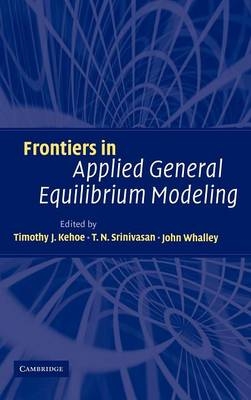
Frontiers in Applied General Equilibrium Modeling
Cambridge University Press (Verlag)
978-0-521-82525-2 (ISBN)
This 2005 volume brings together twelve papers by many of the most prominent applied general equilibrium modelers honoring Herbert Scarf, the father of equilibrium computation in economics. It deals with developments in applied general equilibrium, a field which has broadened greatly since the 1980s. The contributors discuss some traditional as well as some modern topics in the field, including non-convexities in economy-wide models, tax policy, developmental modeling and energy modeling. The book also covers a range of distinct approaches, conceptual issues and computational algorithms, such as calibration and areas of application such as macroeconomics of real business cycles and finance. An introductory chapter written by the editors maps out issues and scenarios for the future evolution of applied general equilibrium.
Timothy Kehoe is Distinguished McKnight University Professor at the University of Minnesota, and an advisor to the Federal Reserve Bank of Minneapolis. He has previously taught at Wesleyan University, the Massachusetts Institute of Technology, and the University of Cambridge. He has advised foreign firms and governments on the impact of their economic decisions. He is co-editor of Modeling North American Economic Integration, which examines the use of applied general equilibrium models to analyze the impact of the North American Free Trade Agreement. His current research focuses on the theory and application of general equilibrium models. T. N. Srinivasan is Samuel C. Park, Jr. Professor of Economics at Yale University. He has previously taught at the Indian Statistical Institute, Delhi and at numerous American universities. He has authored or edited three books including Reintegrating India with the World Economy. He was names Distinguished Fellow of the American Economic Association in 2003. His current research interests include international trade, development, agricultural economics, and microeconomic theory. John Whalley is Professor of Economics at the University of Western Ontario, and is a Fellow of the Royal Society of Canada, the Econometric Society, and a foreign member of the Russian Academy of Natural Sciences. He also holds affiliations with Peking University, NBER, CESifo, and Warwick University. He is well known for his early work on applying general equilibrium as well as tax policy, trade policy, and environmental and development policy. His current research interests include WTO issues and globalization.
List of contributors; Acknowledgements; Introduction Timothy J. Kehoe, T. N. Srinivasan and John Whalley; Part I. General Equilibrium Theory: 1. Personal reflections on applied general equilibrium models Kenneth J. Arrow; 2. Uniqueness of equilibrium in the multi-country Ricardo model Herbert Scarf and Charles A. Wilson; Part II. Computational Methods: 3. Solving dynamic stochastic competitive general equilibrium models Kenneth L. Judd; 4. Mathematical programs with equilibrium constraints: automatic reformulation and solution via constrained optimization Michael C. Ferris, Steven P. Dirske and Alexander Meeraus; Part III. Macroeconomics and Finance: 5. Nonconvexities in quantitative general equilibrium studies of business cycles Edward C. Prescott; 6. Lotteries for consumers versus lotteries for firms Lard Ljungqvist and Thomas J. Sargent; 7. Default and aggregate fluctuations in storage economies Makoto Nakajima and José Víctor Ríos-Rull; 8. New applications of general equilibrium to finance: default and collateral Aloisio Araujo and Mário Páscoa; Part IV. Public Finance, Development and Climate Change: 9. Efficient taxation of income Dale W. Jorgenson and Kun-Young Yun; 10. Representative versus real households in the macroeconomic modeling of inequality François Bourguignon, Anne-Sophie Robilliard and Sherman Robinson; 11. General equilibrium modeling for global climate change Alan S. Manne; Part V. General Equilibrium Restrictions and Estimation of Hedonic Models: 12. Simulation and estimation of hedonic models James Heckman, Rosa Matzkin and Lars Nesheim; Part VI. Policy Uses and Performance of AGE Models: 13. An evaluation of the performance of applied general equilibrium models of the impact of NAFTA Timothy J. Kehoe; 14. Decompositional analysis using numerical equilibrium models: illustrations from trade literature Lisandro Abrego and John Whalley; 15. The influence of computable general equilibrium models on policy Shantayanan Devarajan and Sherman Robinson; Index.
| Erscheint lt. Verlag | 17.1.2005 |
|---|---|
| Verlagsort | Cambridge |
| Sprache | englisch |
| Maße | 152 x 229 mm |
| Gewicht | 830 g |
| Themenwelt | Wirtschaft ► Volkswirtschaftslehre ► Makroökonomie |
| Wirtschaft ► Volkswirtschaftslehre ► Ökonometrie | |
| ISBN-10 | 0-521-82525-3 / 0521825253 |
| ISBN-13 | 978-0-521-82525-2 / 9780521825252 |
| Zustand | Neuware |
| Haben Sie eine Frage zum Produkt? |
aus dem Bereich


